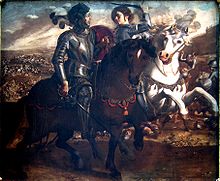User:De la Marck/sandbox2



[1] Wherefore? Clorinda, a warrior woman of the Saracen army, is first introduced in the second canto of the poem, when she rescues Sofronia and Olindo, two Christian lovers of Jerusalem, from death.She is next discovered under the command of the King of Jerusalem, Aladine, aiding that city's defenses, together with the bold knight Argantes.
Clorinda joins the Muslims, but the Christian knight Tancredi (in English: Tancred) falls in love with her (Canto 3). During a night battle in which she sets the Christian siege tower on fire, she is mistakenly killed by Tancredi, but she converts to Christianity before dying (Canto 12). The character of Clorinda is inspired in part by Virgil's Camilla and by Bradamante in Ariosto; the circumstances of her birth (a Caucasian girl born to African parents) are modeled on the lead character (Chariclea) from the ancient Greek novel by Heliodorus of Emesa. To prevent the crusaders from cutting timber for siege engines, the Muslim sorceror Ismen protects the forest with enchantments, which defeat the Christian knights, even Tancredi (Canto 13). Eventually the enchantments are broken by Rinaldo, and the siege engines built (Canto 18). Another maiden of the region, the Princess Erminia (or "Hermine") of Antioch, also falls in love with Tancredi and betrays her people to help him, but she grows jealous when she learns that Tancredi loves Clorinda. One night she steals Clorinda's armor and leaves the city, in an attempt to find Tancredi, but she is attacked by Christian soldiers (who mistake her for Clorinda) and she flees into the forest, where she is cared for by a family of shepherds, with an old man who weaves baskets (Cantos 6-7).
Clorinda joins the Muslims, but the Christian knight Tancredi (in English: Tancred) falls in love with her (Canto 3). During a night battle in which she sets the Christian siege tower on fire, she is mistakenly killed by Tancredi, but she converts to Christianity before dying (Canto 12). The character of Clorinda is inspired in part by Virgil's Camilla and by Bradamante in Ariosto; the circumstances of her birth (a Caucasian girl born to African parents) are modeled on the lead character (Chariclea) from the ancient Greek novel by Heliodorus of Emesa.
References[edit]
The story of Armida, a Saracen sorceress and Rinaldo, a soldier in the First Crusade, was created by the Italian poet Torquato Tasso.
Description[edit]
In his epic Gerusalemme liberata, Rinaldo is a fierce and determined warrior who is also honorable and handsome. Armida has been sent to stop the Christians from completing their mission and is about to murder the sleeping soldier, but instead she falls in love. She creates an enchanted garden where she holds him a lovesick prisoner. Eventually Charles and Ubaldo, two of his fellow Crusaders, find him and hold a shield to his face, so he can see his image and remember who he is. Rinaldo barely can resist Armida’s pleadings, but his comrades insist that he return to his Christian duties. At the close of the poem, when the pagans have lost the final battle, Rinaldo, remembering his promise to be her champion still, prevents her from giving way to her suicidal impulses and offers to restore her to her lost throne. She gives in at this, and like the other Turkish warrior woman, Clorinda, earlier in the piece, becomes a Christian and his “handmaid”.
Many painters and composers were inspired by Tasso's tale. The works that resulted often added or subtracted an element; Tasso himself continued to edit the story for years. In some versions, Armida is converted to Christianity, in others, she rages and destroys her own enchanted garden. She occupies a place in the literature of abandoned women such as the tragic Dido, who committed suicide, and the evil Circe, whom Odysseus abandoned to complete his voyage, but she is considered by many to be more human, and thus more compelling and sympathetic, than either of them.
Category:Literary characters]] Category:Torquato Tasso characters]]
